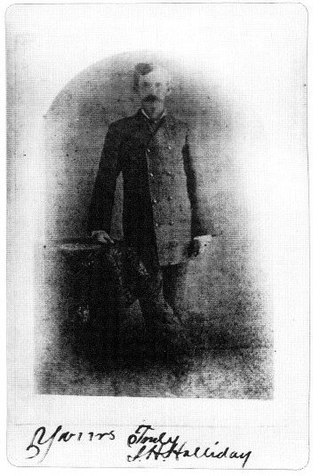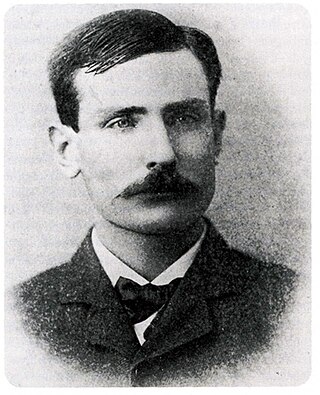
The gunfight at the O.K. Corral was a gunfight that lasted less than a minute between lawmen led by Virgil Earp and members of a loosely organized group of outlaws called the Cowboys that occurred at about 3:00 p.m. on Wednesday, October 26, 1881, in Tombstone, Arizona, United States. It is generally regarded as the most famous gunfight in the history of the American Old West.

John HenryHolliday, better known as Doc Holliday, was a dentist and later a gambler, gunfighter, and a close friend and associate of lawman Wyatt Earp. Holliday is best known for his role in the events surrounding and his participation in the Gunfight at the O.K. Corral in Tombstone, Arizona. He developed a reputation as having killed more than a dozen men in various altercations, but modern researchers have concluded that, contrary to popular myth-making, Holliday killed only one to three men. Holliday's colorful life and character have been depicted in many books and portrayed by well-known actors in numerous movies and television series.

Wyatt Berry Stapp Earp was an American lawman and gambler in the American West, including Dodge City, Deadwood, and Tombstone. Earp was involved in the famous gunfight at the O.K. Corral, during which lawmen killed three outlaw Cochise County Cowboys. While Wyatt is often depicted as the key figure in the shootout, his brother Virgil was both Deputy U.S. Marshal and Tombstone City Marshal that day and had considerably more experience in law enforcement as a sheriff, constable, and marshal than did Wyatt. Virgil made the decision to enforce a city ordinance prohibiting carrying weapons in town and to disarm the Cowboys. Wyatt was only a temporary assistant marshal to his brother.

Virgil Walter Earp was both deputy U.S. Marshal and Tombstone, Arizona, City Marshal when he led his younger brothers Wyatt and Morgan, and Doc Holliday, in a confrontation with outlaw Cowboys at the Gunfight at the O.K. Corral on October 26, 1881. They killed brothers Tom and Frank McLaury and Billy Clanton. All three Earp brothers had been the target of repeated death threats made by the Cowboys who were upset by the Earps' interference in their illegal activities. All four lawmen were charged with murder by Ike Clanton, who had run from the gunfight. During a month-long preliminary hearing, Judge Wells Spicer exonerated the men, concluding they had been performing their duty.

Gunfighters, also called gunslingers, or in the late 19th and early 20th century, gunmen were individuals in the American Old West who gained a reputation of being dangerous with a gun and participated in shootouts. Today, the term "gunslinger" is more or less used to denote someone who is quick on the draw with a handgun, but this can also refer to those armed with rifles and shotguns. The gunfighter is also one of the most popular characters in the Western genre and has appeared in associated films, television shows, video games, and literature.

Bartholemew William Barclay "Bat" Masterson was a U.S. Army scout, lawman, professional gambler, and journalist known for his exploits in the late 19th and early 20th-century American Old West. He was born to a working-class Irish family in Quebec, but he moved to the Western frontier as a young man and quickly distinguished himself as a buffalo hunter, civilian scout, and Indian fighter on the Great Plains. He later earned fame as a gunfighter and sheriff in Dodge City, Kansas, during which time he was involved in several notable shootouts.

Timothy Isaiah Courtright, also known as "Longhair Jim" or "Big Jim" Courtright, was an American Deputy Sheriff in Fort Worth, Texas from 1876 to 1879. In 1887, he was killed in a shootout with gambler and gunfighter Luke Short. Before his death, people feared Courtright's reputation as a gunman, and he reduced Ft. Worth's murder rate by more than half, while reportedly extracting protection money from town business owners.

Luke Lamar Short was an American Old West gunfighter, cowboy, U.S. Army scout, dispatch rider, gambler, boxing promoter, and saloon owner. He survived numerous gunfights, the most famous of which were against Charlie Storms in Tombstone, Arizona Territory, and against Jim Courtright in Fort Worth, Texas. Short had business interests in three of the best-known saloons in the Old West: the Oriental in Tombstone, the Long Branch Saloon in Dodge City, and the White Elephant in Fort Worth.
David Rudabaugh was a cowboy, outlaw, and gunfighter in the American Old West. Modern writers often refer to him as "Dirty Dave" because of his alleged aversion to water, though no evidence has emerged to show that he was ever referred to as such in his own lifetime.

The Dodge City War was a bloodless conflict that took place between Luke Short and the Dodge City mayor, who tried to force Short to close the Long Branch Saloon and leave town. Luke called on several friends, including Wyatt Earp and Bat Masterson, who supported him during his confrontation from April 28 to June 7, 1883. The event is best remembered because it produced one of the most iconic photos of Western gamblers and gunfighters who played roles in the history of the Wild West.

James Cooksey Earp was a lesser known older brother of Old West lawman Virgil Earp and lawman/gambler Wyatt Earp. Unlike his brothers, he was a saloon-keeper and was not present at the Gunfight at the O.K. Corral on October 26, 1881.

Charles E. Bassett was a lawman and saloon owner in the American Old West in Dodge City. He was one of the founders of the Long Branch Saloon in Dodge City, served as the first sheriff of Ford County, Kansas, as well as city marshal of Dodge City. His deputies included Wyatt Earp and Bat Masterson.

James Patrick Masterson, was a lawman of the American West and a younger brother of gunfighters and lawmen Bat Masterson and Ed Masterson.

The Long Branch Saloon was a well-known saloon in Dodge City, Kansas, from about 1874 to 1885. It had several owners, most notably Chalk Beeson and gunfighter Luke Short. The establishment provided gambling and live entertainment, including Beeson's five-person orchestra. It was the scene of several altercations, shoot-outs, gunfights, and standoffs often associated with cattle towns in the American wild west. Most famous was the 1879 Long Branch Saloon Gunfight, in which Frank Loving killed Levi Richardson.
The Variety Hall shootout, also called the Las Vegas Saloon Shootout, was a gunfight that took place in Las Vegas, New Mexico, United States. It launched gunman "Mysterious" Dave Mather to fame.
Frank Loving, sometimes called "Cockeyed" Frank Loving, was an Old West gambler and gunman. He was involved in two well-publicized shootouts of the day.
Levi Richardson was an Old West gunman, gambler and buffalo hunter. During his lifetime, Richardson was quite well known.
Billy Thompson, sometimes known as Texas Billy Thompson was an Old West gunman and gambler, and the younger brother of the famous gunman and lawman Ben Thompson. The younger Thompson brother never achieved the fame that his brother achieved, and in his own lifetime was mainly referred to as the unpredictable and troubled younger brother of Ben Thompson. Factually, however, while a dangerous man, he also was a formidable opponent in a gunfight.
Pat Desmond was a lawman and gunman of the American Old West. He was listed as one of the twelve most underestimated gunmen of the Old West in the book "Deadly Dozen", written by Robert K. DeArment.
James H. Leavy was an Irish gunfighter in the Old West. He is remembered today by Western historians for participating in at least two instances of a quick draw duel. In his time, Leavy was one of the most notorious gunmen in the Old West known for challenging other gunmen to a duel. He is featured in the book Deadly Dozen, written by author Robert K. DeArment as one of the twelve most underrated gunmen of the 19th century West.













